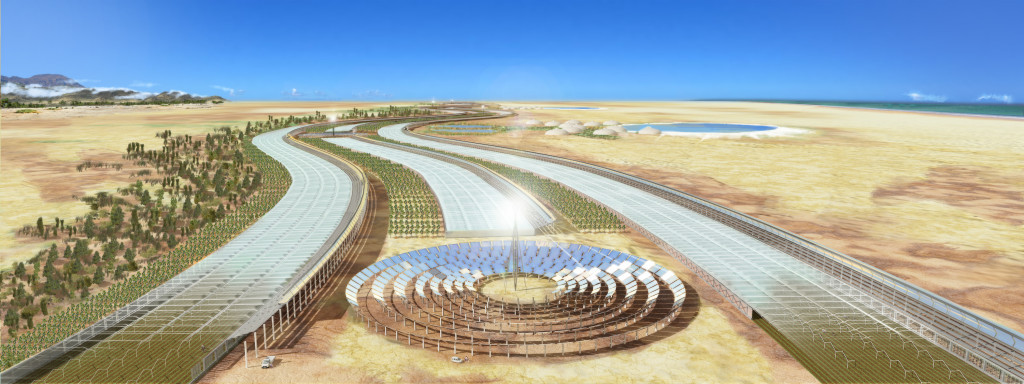
The Sahara Forest Project is a new environmental solution designed to utilize what we have enough of to produce what we need more of, using deserts, saltwater, sunlight and CO2 to produce food, water and clean energy.
The Sahara Forest Project has set out to establish groups of interconnected economic activities in low-lying desert areas around the world. The simple core of the concept is an infrastructure for bringing saltwater inland. Through establishing this saltwater infrastructure, The Sahara Forest Project aims to make electricity generation from solar power more efficient, operate energy- and water-efficient Saltwater-cooled greenhouses for growing high value crops in the desert and sequestering CO2 through revegetation of desert lands.
Enabling a Restorative Growth for Tunisia
Tunisia has a climate and geography that is particularly well-suited to take advantage of The Sahara Forest Project concept and technologies. With support from The Norwegian Ministry of Foreign Affairs, The Sahara Forest Project is therefore initiating a number of activities in Tunisia:
• Development of Feasibility Study to investigate the potential for realization of Sahara Forest Project facilities in Tunisia.
• Development of a comprehensive study to identify sustainable technological solutions that can contribute to increased food, water and energy security in Tunisia
• The Sahara Forest Project will conduct a program for business development in Tunisia to develop public and private partnerships motivated to realize sustainable growth opportunities
• Organization of a high-level event in Tunisia in 2016 with focus on solutions contributing to increased food, water and energy security
Calling for research abstracts – deadline June 1st 2016: http://bit.ly/1NlboCd
Integrated technologies
Saltwater-cooled greenhouses
Saltwater-cooled greenhouses utilize saltwater to provide suitable growing conditions for year-round cultivation of high-value vegetable crops in hot and arid environments. By using saltwater to provide evaporative cooling and humidification, the crops’ water requirements are minimized and yields maximized with a minimal carbon footprint. Sahara Forest Project pilot operations in Qatar confirmed that yields are competitive with that of leading European greenhouse operations. The freshwater usage is half of comparable greenhouses in the MENA-region.
Solar Technologies
Sahara Forest Project utilizes solar power technologies to provide power for electrical installations in the SFP-facility, while the majority of the power can be exported. Both Photovoltaics (PV) and Concentrated Solar Power (CSP) can be used to provide electricity and heat. Dust arresting from the surrounding vegetation and water for cleaning the PV-panels and CSP-mirrors ensure efficient electricity generation. During pilot operations saltwater-cooled greenhouses provided cooling of the CSP-facility, without construction of traditional freshwater-based cooling towers.
Revegetation
Desert revegetation is catalyzed by a combination of efficient watering regimes, soil reclamation techniques and evaporative cooling. Sheltered and humidified cultivation areas host both native desert species and water-efficient food and fodder crops. Nitrogen-fixing and salt-removing desert plants can be deployed in concert with repurposed agricultural waste products and saltwater evaporation to improve soil conditions and boost crop yields.
Extensions
By establishing a commercially viable way to bring saltwater into the desert, The Sahara Forest Project works as an enabling technology, creating opportunities for a wide range of businesses to develop alongside it. These opportunities include salt extraction, traditional desalination, algae production, halophyte cultivation, mariculture, bioenergy and more.
